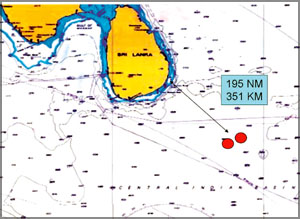LTTE in the doldrums after Navy blasts weapons ships
One of four pillars sustaining Tigers crumbling:
 HEAVY
BLOW TO LTTE: The existence of the LTTE, according to analysts,
depends on four major pillars supported by financial, arms procurement,
propaganda, diplomatic and political networks maintained by the Tiger
hierarchy. HEAVY
BLOW TO LTTE: The existence of the LTTE, according to analysts,
depends on four major pillars supported by financial, arms procurement,
propaganda, diplomatic and political networks maintained by the Tiger
hierarchy.
The collapse of any of these pillars puts them in an unbalanced
situation, thus heralding the disintegration of the organisation. If any
effort made to banish the LTTE, considered to be the most ruthless
terror organisation, there should be direct focus on these four pillars
that ensures on its existence.
If any nation or any organisation is willing to see an end to the
terror activities of the LTTE, there should be a compulsion on their
part to remove these pillars.
That was the appeal the Sri Lankan State made to the international
community over the past few years to eliminate those pillars that
strongly supported the LTTE to continue their unlimited terror acts.
One of the main pillars, the international arms procurement network
of the LTTE run by Kumaran Pathmanathan (KP), faced severe blows at the
hands of the Sri Lankan Navy for the past few months, specially within
last 18 months.
The arrest of the second in command of the KP Department of the LTTE
in Indonesia last year and the exposure of the LTTE arms smuggling network by the FBI were some of the
major breakthroughs.
exposure of the LTTE arms smuggling network by the FBI were some of the
major breakthroughs.
Dealing a severe blow to the KP Department of the LTTE, the Navy
recorded its biggest victory in its 56 year history on March 18, having
succeeded in their months long effort to track down Tiger ships
smuggling arms to the country.
Never in its history had the Navy been able to destroy two enemy
ships within one day and three ships within three weeks.
According to Navy Commander Wasantha Karannagoda it was due to their
commitment and dedication to collect intelligence on the LTTE arms
smuggling network that resulted in these successes.
The intelligence reports indicated that two ships were heading
towards Sri Lankan territorial waters with huge stocks of arms and
ammunition. The Navy was determined to track the unknown ships.
The Navy made use of its maximum resources to gain the upper hand,
using four Offshore Petrol Vessels, Sagara, Suranimala, Samudura and
Sayura.
Two of these OPVs left the Colombo Port on March 15, three days
before the incident and entered the high seas in the Eastern coast in
the sea off Kalmunai and kept alert on any suspicious craft heading
towards Sri Lanka.
The other two OPVs also left Colombo on March 16 and headed in the
same direction in search of the suspicious ships heading towards Sri
Lanka.
The two OPVs that left Colombo on March 16 had the first clue about
the suspicious LTTE ship as the echo was traced in the radars of the
ship around 2.30 am on March 17.
Navy Commander Vice Admiral Karannagoda, Director General
(Operations) Commodore Susith Weerasekera and Director Naval Operations
Captain S.S. Ranasinghe gathered at the Operations Room of the Navy
Headquarters in Colombo as they got information about the suspicious
ship.
The Operations Room gave clear instructions to the ship Captains to
keep an eye on the ship till first light the next day until they get a
clear view of the ship so that they can make sure they have not got the
wrong target.
As the sun cast its rays on the ships on March 18 morning the
Operations room instructed the ship Captains to communicate with the
ship through channel 16, since it was not carrying any flag.
They talked to the ship through the International Maritime Radio
Communication Channel (Channel 16) around 7 a.m.
The Navy asked the IMO registration number (International Maritime
Organization registration number), the last port of call, next port of
call and details of the crew members of the ship.
It took only a few minutes for the officials at the Operations Room
to find that the information given by the suspicious ship was not true
as they did not tally with the Lloyds Registry.
As Navy got confirmation that they have tracked the LTTE ship
correctly the ship started to move towards the Western coast and the
Navy fired warning shots across the bow and challenged the ship.
As the ship started fleeing without heeding the Navy orders, the Navy
fired over the bow of the ship as they got confirmation that it was the
exact ship they were looking for as the length of the ship and its
colour corresponded with the intelligence reports.
The Navy came to this conclusion, not because they were suspicious of
the ship but they could verify they were attacking the exact ship
transporting arms to the LTTE through the intelligence gathered
throughout the past six months.
As the ship came under Navy fire, there was a big explosion within
the ship and it sank in the 4,000 meters deep sea 195 nautical miles
South East of Arugam Bay without leaving any clue.
While the drama was unfolding in the Exclusive Economic Zone in the
South East of Arugam Bay, the other two ships that left Colombo on March
15 detected another ship around 20 Kilometres west of the first ship
around 6.30 am.
The Operations Room of the Navy Headquarters was alerted about this
ship too. The Navy talked to the ship through Channel 16. As the details
given by the ship were proved wrong the Navy engaged the ship with their
guns and the ship was sunk around 12.45 pm with short explosions inside
the ship.
It has now been revealed that the first ship had transported parts of
three light aircraft, surface to air missiles, torpedoes, radars, night
vision equipment, GPS units and outboard motors to be delivered to Wanni.
The Navy believe that the two ships have come from Indonesia carrying
war like items to be moved towards the Southern coast of Sri Lanka
mingling with the ships sailing on the international shipping route that
runs close to the Southern coast of the country.
Instead of their earlier practice of unloading these ships close to
the coast of Mullaitivu, the LTTE has opted to unload the shiploads of
arms and ammunition to fishing trawlers or small ships after stationing
the mother ship in international waters close to the Southern part of
the country.
They then transfer the arms and ammunition to small boats so that
they could afford to lose one or two boats once they are detected by the
Navy in the Sri Lankan territorial waters.
The Navy had these successes as they dared to go into the deep sea
and trace these suspicious ships rather than waiting to detect boats
transporting smaller consignments of arms and ammunition.
According to information, the Navy destroyed arms and ammunition
valued at US$ 25 million as the two ships were transporting nearly 2,500
metric tonnes of such items.
The LTTE which is already undergoing severe shortage of ammunition
will see the consequences of the loss of these two ships in the coming
weeks in face of the military operations carry out in the East. |

